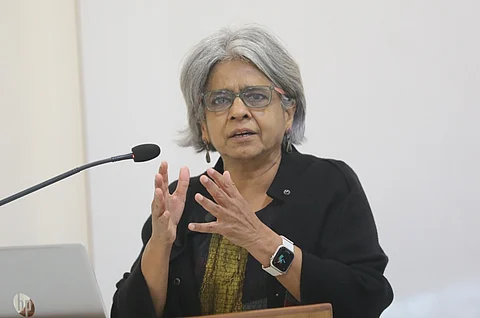

India suffers from acute energy poverty; consequently, it will have to double its energy capacity and generation by 2030. This means coal cannot be replaced; it would have to be methodically displaced by clean energy sources, Director-General of Centre for Science and Environment (CSE) Sunita Narain said on December 9,2024.
Narain made the statement at a 2-day ‘National Dialogue on Renewable Energy for an Equitable Green Transition’, organised by CSE at the Anil Agarwal Environment Training Institute, located in Nimli, near Alwar.
The displacement Narain referred to, has already started happening. CSE researchers point out that though coal is still the “king” — with 217.5 GW installed capacity out of a total of 440 GW — it is losing its place.
Energy generated from fossil fuels (coal, lignite and gas) is expected to dip from 77 per cent of the total in 2024 to 56 per cent by 2030.
“The more dramatic change would be in the contribution of new renewables — from 13 per cent today, they would be expected to generate 32 per cent by 2030,” said Narain.
“A ‘green’ transition in India’s energy sector is about reducing energy poverty and mitigating climate change. Renewable energy is critical for addressing both — the question is, is India ready for that transition? Will it be able to meet its 2030 target of achieving 50 per cent cumulative electric power capacity from non-fossil fuel sources?” asked Narain.
She added: “The challenge for the country is to augment the power infrastructure, make it clean, and supply electricity at affordable rates. The good news is that the Government of India is absolutely committed to this transition. An ambitious but feasible target has been set. We are hoping it will provide the green energy transformation that we desperately need,” said Narain.
India is working towards reducing its emissions intensity by 45 per cent by 2030 (compared to 2005 levels). It has also said, as Narain mentioned, that by 2030, 50 per cent of its energy capacity will be from renewable (non-fossil fuel) sources. The country’s target for installed renewable energy capacity has been hiked — from 175 gigaWatt (GW) by 2022 to 500 GW by 2030.
India’s power demand is expected to surge by 2-2.5 times by 2047, says the 2024 Economic Survey. The Central Electricity Authority (CEA) says that the growing demand will need 777 GW of total installed capacity by 2030 — 44 per cent of this demand will be met by the 500 GW of non-fossil fuel sources that the country is planning to install.
The CEA says 426 GW of new renewables will need to be installed — solar power would be the driver of this clean energy future. It will supply 23 per cent of the total power generated in India by 2030.
Nivit Kumar Yadav, programme directors (industrial pollution unit), CSE, said: “Installed capacity of clean energy has increased — India ranks fourth in the world today for renewable energy capacity addition. From 32 per cent of the total, installed capacity of non-fossil fuel-based power has climbed up to 45 per cent.”
CSE researchers point out that there is now a need to also scale up generation. India does not have a stated target for percentage of generation of non-fossil fuel-based energy in the total energy mix. New RE (renewable energy) accounts for only 13 per cent of the total generation (2023-24).
One concern that the CSE investigation has unearthed is the fact that while on one hand many projects are yet to be commissioned, on the other there appear to be very few takers for renewable source-based power. The website of the Solar Energy Corporation of India (SECI) says 34.5 GW of projects remain uncommissioned, despite their PPAs (power purchase agreements) having been already signed.
Pradip Kumar Das, head of IREDA, noted at the Dialogue: “By 2030, India would need investments of around Rs 30-32 lakh crore in renewable energy. To scale up renewable energy, capital investment must be fast tracked; at the same time, risks emerging from land conversion and transmission delays need to be reduced.”
Manu Srivastava argued that “to improve RE penetration in India, the sector needs to be economically viable. India needs to tailor its power demand based on solar generation, instead of trying to make solar mimic thermal power”.
Harish Hande of SELCO India advocated that “linking energy with health and livelihoods will help integrate RE better, rather than a single pursuit of energy generation alone”.
In her address, Narain stressed on the fact that “India has good governance systems that are still evolving. What needs to be focused on are efforts to bring down the capital costs of large plants, try and de-risk the plants, and try and ensure there are effective agencies in place to do the bidding and tendering, agencies that can act as intermediaries that can ease the processes of buying and selling.”
“RE transition is about the politics of inclusion. Only if growth — the cost of energy — is affordable, can it be sustainable,” she added.